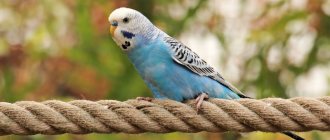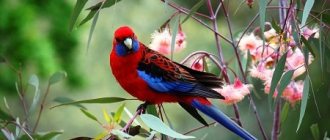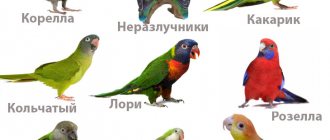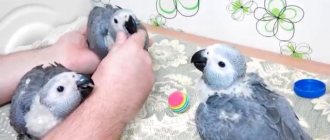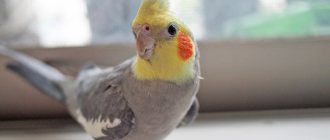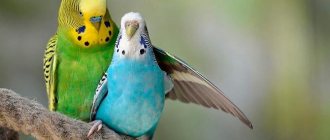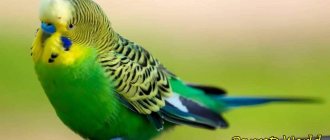Most people keep cats or dogs at home. Parrots, especially large ones, are still considered exotic, despite the fact that caring for them is much easier and they bring no less joy. Our family decided to get a large parrot, since we had heard a lot about their intellectual abilities and already had experience in keeping birds - budgerigars. Since then, for nine years now, our Eva, a noble parrot, or eclectus, has been pleasing us with her company.
As a pet, a parrot has many advantages.
Parrots have no hair
Instead of fur like dogs or cats, parrots have “powder.” These are tiny horny particles of down feathers that resemble talc in properties and are needed to repel water if the bird gets wet. But certain species of parrots (Eclectus are one of them) do not produce any powder, but have sebaceous glands. Such birds are suitable even for those who are allergic to feathers.
In addition, parrots are not as odorous as other animals. A healthy, well-groomed bird smells like honey or sun-dried feathers.
What you need to know before getting a parrot at home
Firstly, you need to know that birds, like other animals, are susceptible to various diseases. And among these pathologies there are a number of diseases common to humans. The first thing that should cause concern is ornithosis (psittacosis), an infection transmitted to humans. To prevent infection with this disease, first of all, you need to buy a parrot from a trusted place (in a pet store or from a breeder with a good reputation), and also pay attention to its health status when purchasing. A healthy bird has good plumage and shiny eyes. In addition, the parrot must be quite active and energetic. Sneezing, diarrhea, refusal to feed, discharge from the eyes or beak, depression should alert the buyer, and if such symptoms are observed in a bird already living at home, you should immediately contact a veterinary clinic.
Parasitic diseases are also widespread in birds. The most common are knemidocoptic mange (bird mite), in which whitish-gray spongy growths around the beak and on the legs are observed, and mallophagosis (feather-eaters), accompanied by restlessness, itching, and partial loss of plumage. Helminthiases are also possible in birds.
In addition, parrots suffer from nutritional diseases associated with improper feeding. To prevent them, it is necessary to ensure that the bird’s diet is varied, and to avoid sudden changes in feed or feeding with poor-quality feed.
Diseases in parrots develop very quickly, so the owner of the bird should immediately contact an ornithologist if symptoms such as apathy, refusal to feed, diarrhea, discharge from the eyes or beak, or ruffled plumage appear. In addition, it is advisable to visit a doctor immediately after purchase to get advice on feeding and maintenance, as well as to conduct an initial examination of the bird.
Even if your parrot is energetic, active and looks quite healthy (he has good plumage, shiny eyes), after purchase it is recommended to consult a veterinarian, or rather an ornithologist. Only such a specialist will be able to promptly recognize the presence of pathologies in a pet. For any purchased bird, an examination is recommended, including: a general clinical examination, during which the doctor will examine the condition of the feathers, skin, mucous membranes, identify fatness, the presence of tumors, examine the condition of the musculoskeletal system, listen to the heart and lungs; laboratory tests of blood, feces, microbiological smears from the cloaca and goiter (to identify pathogens of infectious diseases).
It should be remembered that diseases in birds are often asymptomatic, so you cannot be sure of the health of the purchased bird without a specialist’s opinion.
Parrots can learn to talk
Parrots are great imitators. They can reproduce the hum of a washing machine, a telephone ringtone, or the sound of a doorbell. If you are patient and work with the bird, it will learn not only to pronounce individual words and phrases, but also to repeat sentences in the right sequence. Our parrot, for example, knows how to tell a fairy tale about the Ryaba Hen and laughs very contagiously.
The talkativeness of a parrot largely depends on its species. The first place is rightfully occupied by African gray parrots, followed by Amazons. Cockatiels and budgies can also learn to speak up to a hundred or more words.
In order for a parrot to learn to talk, it is better to keep it alone, without other birds, so that a lack of communication arises, which will encourage the bird to make contact. The secret of training is simple: you need to practice regularly, pronounce the words emotionally and do not forget to praise and encourage your pet with his favorite treats. Sometimes the best reward for a bird is to scratch the top of its head against the feathers.
Talking parrots for home: the best breeds
Every person sooner or later thinks about the need to get a pet. Cats and dogs are excellent companions, but they require special care - brushing, vaccination, bathing and walking. If family members are away from home for a long time, these animals become depressed or howl and whine, causing indignation among neighbors.
House parrots are a different matter. Cute, funny creatures know how to entertain themselves in the absence of their owners, easily cope with the necessary hygiene procedures on their own, and are unpretentious in their diet. A cage with a bird does not take up much space and adds zest to the interior. Birds are often chosen as pets by people who are allergic to animal fur.
Photo: pixabay.com: UGC
Domestic parrots chirp cheerfully and have bright plumage. They are exotic and unique. Some types of parrots easily remember and imitate sounds. They can be taught words and phrases. In this case, you will get cute and comical interlocutors. Buying a parrot is easy. But before you go to the store, decide what breed of parrot you would like to have:
Budgerigar
Photo: pixabay.com: UGC
Beautiful and sociable, active and cheerful, budgies are wonderful companions and friends. They are small in size: they grow up to 15–18 cm and weigh up to 40 g. Therefore, they will need a small cage. They live 5–15 years.
This breed is easy to train: they are taught to sit on a shoulder or arm and talk. However, only males can be trained and only when there is no extraneous interference - objects, animals or birds that make sounds.
Start talking to your bird as soon as it is one month old. The older she gets, the more difficult science becomes. After the parrot has learned a few words, buy him a female. Budgerigars get bored alone and constantly need someone to talk to. During the absence of the owners, this role will be played by a girlfriend.
Budgerigars, unlike other breeds, are less noisy, but love freedom. They begin to fly around the apartment after a short adaptation (after a week or two).
Jaco
Photo: pixabay.com: UGC
If you want to have a real talking parrot at home, then buy a Gray parrot. These birds are large in size (they grow up to 35 cm and weigh up to 400 g). They live long - from 20 to 50 years. They have unsightly colors (gray-white plumage), but enormous learning abilities.
This is the only breed whose representatives not only remember short phrases or words, but are able to conduct a dialogue with their owners. They are talkative and create a lot of noise: they shout over the TV, comment on what is happening, sing, and “help” their owners talk on the phone. Those who get such a pet often ask how to teach it to be silent rather than to speak.
Jacos are smart and impressionable. They vitally need attention and love. They need a large cage with a lot of toys, as well as a perch in the room from which the Gray will watch what is happening. Any harsh word or shout towards them can cause stress, as a result of which the bird will begin to pluck its feathers.
Jaco and order are incompatible concepts. They scatter food and scatter feathers around the apartment. Therefore, you will have to clean the room twice as often.
Corella
Photo: pixabay.com: UGC
The cockatiel parrot is a member of the cockatoo family, found in Australia. Their catching and export is prohibited, but representatives of this breed have long been domesticated and reproduce well in captivity.
Their distinctive features are bright plumage in males, red or pink “apples” on the cheeks, a characteristic curved beak and a flirtatious crest on the head. These are medium-sized parrots: the body length reaches 33 cm, while the tail is half of this length. Corellas weigh a little - up to 150 g. They live up to 18 years.
The parrots, photos of which are given below, are distinguished by a variety of colors. The classic breed type has olive-gray plumage, but there are white, yellow, cinnamon and pearl gray cockatiels.
Photo: pixabay.com: UGC
Corellas are school birds, so loneliness is contraindicated for them. For normal bone and muscle development, these parrots need to fly. Therefore, it is best to keep them in a special enclosure attached to the house, or in a large cage. If you live in an apartment, then your cockatiels will have to be let out of their cage so that they can exercise. Corellas are clean and unpretentious in their diet.
Photo: pixabay.com: UGC
Parrots of this breed are less trainable than budgies. They will learn up to a hundred words from a persistent owner, but their conversation will more likely resemble muttering than articulate speech. When cockatiels are upset or angry, they may peck painfully.
Amazon
Photo: pixabay.com: UGC
Representatives of this breed come from the Amazon forests. Parrots are large in size (they reach 41 cm in length and weigh up to 700 g). They have green plumage, and some representatives have red spots on the head, tail and wings. A distinctive feature is their pointed, massive beak, which they use to crush nuts. On average they live 35–50 years.
Amazons are great imitators. Don’t be surprised if your pet suddenly starts meowing or barking like a cat, repeats the sounds of a washing machine or car horn, or sings his favorite tune. Their level of intelligence is lower than that of Grays, but they perfectly repeat any sounds, including human speech. True, they do it thoughtlessly.
They quickly get used to their owners, strive to be the center of attention, love freedom, although they are happy to sit in a large cage on a perch. The main thing is that their home should be located away from heating devices, protected from drafts and locked from the outside with a padlock. Otherwise, the quick-witted Amazon will open it with his beak and fly out.
Rosella
Photo: pixabay.com: UGC
This breed of parrot is native to the island of Tasmania and southern Australia. Its representatives are small (up to 30 cm in length and weigh up to 100 g), but are brightly colored: the plumage contains red, yellow, green and blue colors. They live up to 30 years.
Rosellas are sociable and quickly get used to their owners, love attention and affection, try to earn encouragement and attract attention to themselves in every possible way. But they do not like their relatives and can even attack competitors.
Photo: pixabay.com: UGC
Parrots of this breed have a pleasant voice and sing with pleasure. They have a fairly high intelligence, which is manifested in memorizing rules of behavior, words and phrases. Rosella meows, croaks and barks with pleasure.
Photo: pixabay.com: UGC
Talking parrots are a special category of pets. These are socially oriented birds that require active communication with humans. When you decide to get a parrot, ask how to create comfortable conditions for it and how to monitor the health of your talking companion.
They are distinguished by their intelligence and intelligence
The gray parrot, or African gray parrot, is rightfully considered the most capable. This species can even analyze and reason logically at a basic level. Parrot Alex (by the first letters Avian Learning EXperience), one of the representatives of this breed, was specially chosen for the experiment by Dr. Irene Pepperberg. The psychologist set out to prove that parrots are capable of not only imitating sounds, but also making conscious decisions.
Jaco could identify up to 50 different objects and describe their colors, shape and material. Alex had the ability to be aware of the concepts of "more", "less", "same", "different", "above" and "under". His vocabulary was about 150 words, but that was not even his main feature.
The parrot was able to understand what he was saying, could ask a question, make a request and ask again if he was not given what was promised, or even complain of fatigue.
Alex reached the intellectual level of a five-year-old child and the emotional level of a two-year-old, and, according to the researcher, this was not the limit. Alex died at the age of 31. The last words he said to the hostess: “Be good. See you tomorrow. I love you".
Parrots are social animals
Parrots, like people, love communication and try to avoid loneliness. If a bird is deprived of company, it may develop depression, which can lead to self-plucking syndrome. That is, stress forces the bird to pluck its feathers.
At the same time, parrots are able to occupy themselves, for example, with the help of mirrors and baby rattles, and do not require much attention. When you go to work or are busy with business, your feathered friend can be placed in a cage.
If you raise a parrot, it can be no less affectionate and loving than a dog or cat. There are many examples when birds miss their owners and cannot even imagine their existence without their family. And our parrot is no exception: Eva is always sad when we go on vacation and rejoices at our return.
Easy to maintain
You need to clean up feathers and droppings after your parrot. Daily cleaning of the cage is much easier than endless cleaning of the litter box and hour-long walks outside. To keep your parrot healthy, it is enough to bathe it once a week and trim its claws in a timely manner. The birds take care of the cleanliness of their feathers themselves, regularly tidying themselves up.
Providing a balanced diet is also not difficult. In addition to high-quality store-bought food, the bird’s diet should include fresh fruits and vegetables (except avocados). Some parrots, especially large ones, benefit from sprouted grains: wheat, buckwheat, oats, mung bean.
For our family, feeding the parrot became an incentive to start sprouting: sprouts are also good for humans because they contain minerals, vitamins and enzymes.
Pet parrots: main care questions
For the most part, parrots are unpretentious in care, but there are some secrets to their arrangement in the room, nutrition, hygiene and preventive procedures. Let's talk about this in more detail:
How to choose a cage?
A spacious and comfortable cage with toys and perches is a prerequisite for maintaining the physical and psychological health of impressionable parrots. Choose a cage in which the bird can not just straighten its wings, but fly.
Photo: pixabay.com: UGC
The distance from perch to perch should allow the bird to make at least four wing beats, then muscle tone will be normal. Amazons and cockatiels are best kept in enclosures measuring one meter by one meter.
Should a parrot be allowed to fly indoors?
Domestic parrots are poorly oriented in the space of the apartment, which is why they get injured. They are overly curious, so they can look into the kitchen, where they will singe their wings or taste salt - and this is poison for them. They can hit a closed window with acceleration or fly out onto the balcony, and from there onto the street. In addition, parrots enjoy peeling wallpaper and pecking furniture.
Photo: pixabay.com: UGC
However, it is necessary to let your pets out of the cage for a short time so that they can fly. Do this by taking certain precautions: limit the flight to the space of one room, in which curtain the windows with curtains or blinds, close the doors to this room.
Chicks and young birds that are no more than 2 months old, birds that have just been acquired and have not yet had time to adapt to their new home should not be released into free flight.
What to feed and water parrots?
Pet parrots need special balanced and fortified food, which is sold in pet stores. Owners independently determine the treats their pets prefer: offer them dried fruits or nuts, seeds or millet.
Photo: pixabay.com: UGC
To make it easier for parrots to sharpen their beaks, bring branches of cherry or apple trees with buds. Take branches from trees that have not been treated with chemicals. Pour purified or boiled, cooled water into the drinking bowl.
What hygienic and preventive procedures should a parrot carry out?
Parrots take care of themselves on their own: they bathe in a drinking bowl, pluck feathers, and grind off their claws. If the bird cannot handle the claws on its own, then use a special nail clipper to help the bird.
Photo: pixabay.com: UGC
Parrots that live outside in an aviary must be vaccinated against Newcastle disease once a year. To do this, buy a dose at a pet pharmacy and add it to the water.
Birds that live indoors do not require vaccination, but in the summer they are given prophylaxis against rickets. To do this, expose cages with pets to the sun's rays, but make sure that the bird does not overheat.
How often do you communicate with birds?
Parrots are social birds. To prevent them from getting sick, give your birds at least an hour a day. At the same time, do not be distracted by other pets or family members. If a parrot feels that its owner is ignoring it, it will get sick.
You should also take precautions if there are cats in the house. Small parrots will easily become their prey, and large specimens can themselves attack a cat that is showing aggression.
Study the requirements for caring for talking parrots and decide on the choice of breed. Buying an exotic bird is not only fun, but also a responsibility. Bright and intelligent parrots will delight their owners every day with cheerful singing and conversations if they receive proper care.
